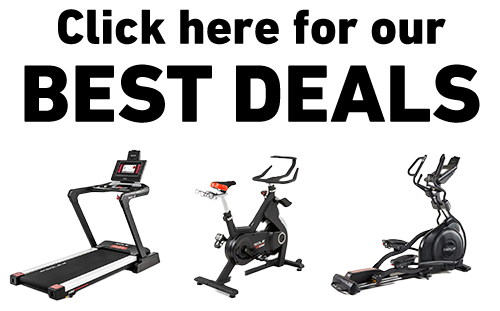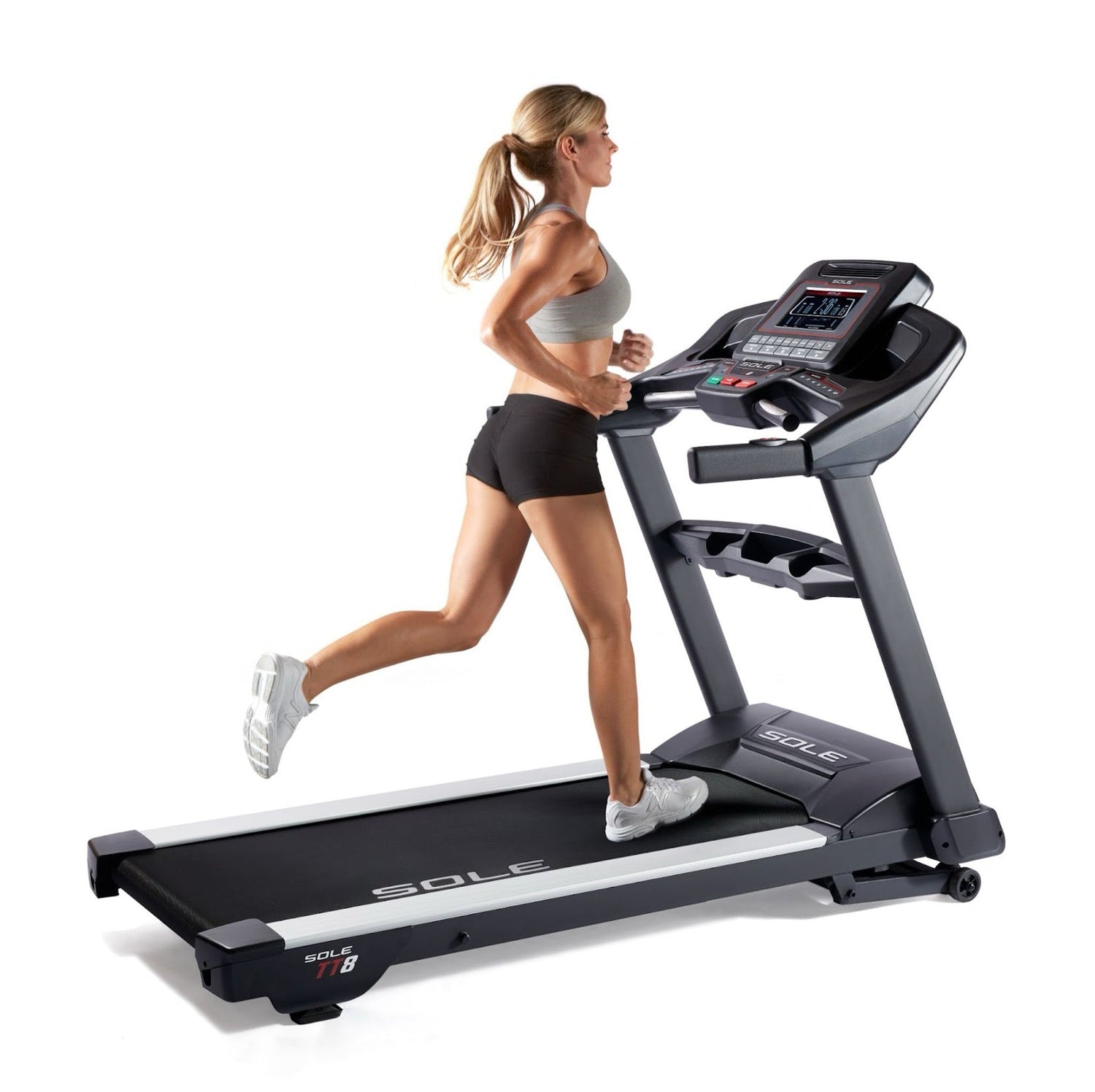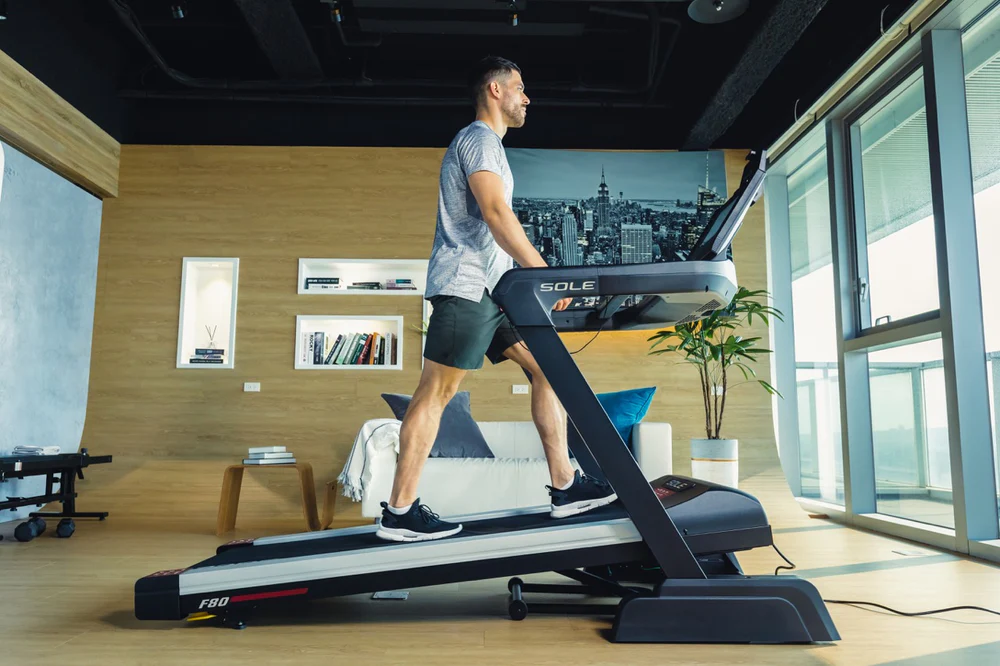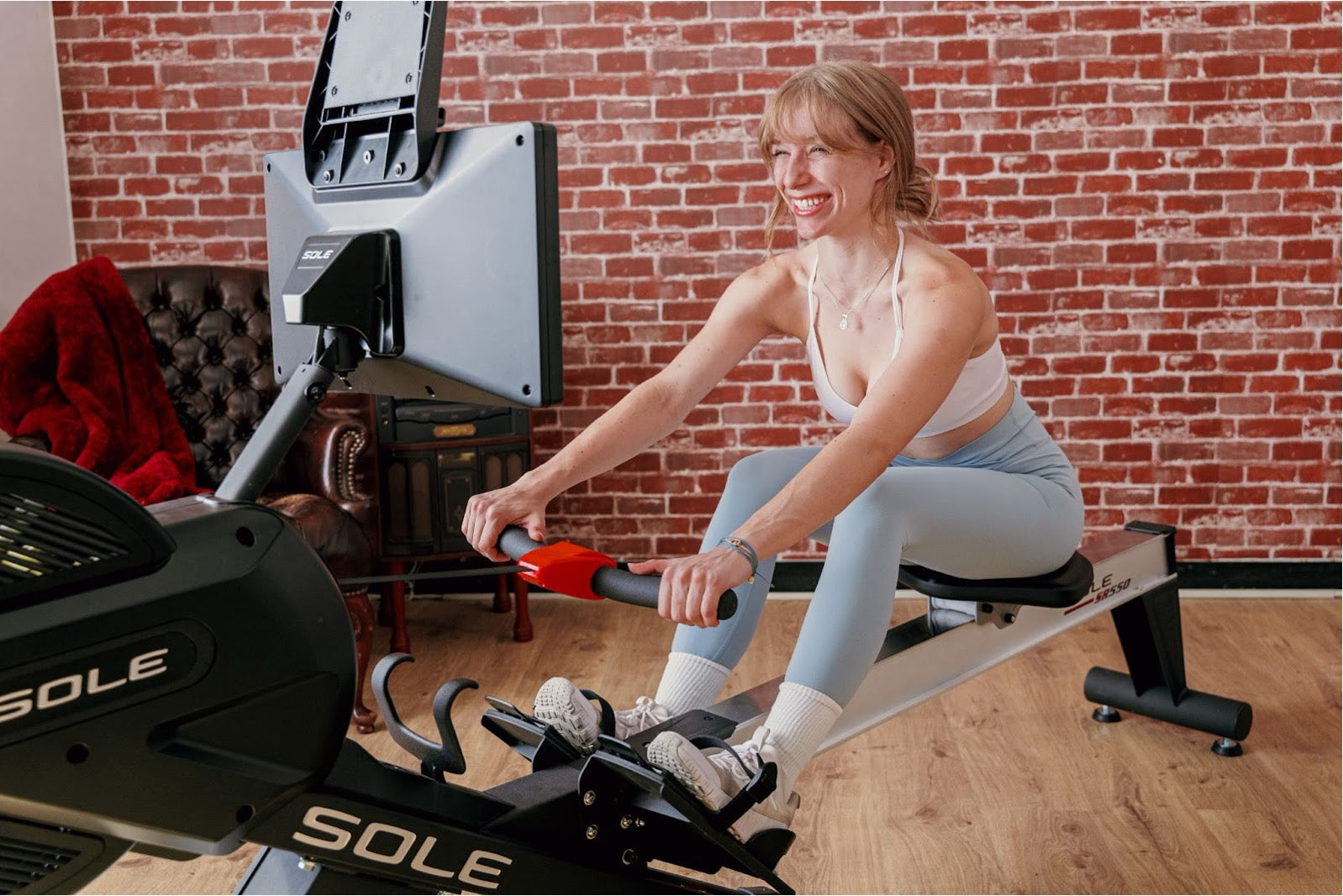Key Takeaways
- Treadmill workouts can strengthen core and back muscles while improving posture to reduce lower back pain.
- Start with gentle, low-intensity workouts and gradually increase difficulty to avoid aggravating pain.
- Maintain proper form and posture - stand tall, head up, core engaged, and arms swinging naturally - to ensure that you’re not aggravating your lower back pain.
- Proper warm-ups and cool-downs are essential when dealing with back pain.
- SOLE treadmills help manage lower back pain with low-impact, customizable workouts, thanks to the Cushion Flex deck that reduces joint stress while strengthening core muscles.
Why Treadmill Workouts are Effective for Lower Back Pain
So why bother with a treadmill when your back feels like it's being stabbed by tiny angry elves? It's all about building strength and improving your posture!
When you walk or run on that moving belt, you’re working your core and lower back muscles without even realizing it. Plus, it helps you stand up straight instead of slouching like a cave troll.
The best part? You’re in control! You can adjust the speed, slow it down, or add an incline—whatever feels right for you. Start off easy and gradually increase the intensity when your body feels ready.
This gradual approach means you won’t push yourself too hard and risk more pain down the line.
|
At SOLE, we're proud to offer top-quality exercise equipment designed for home and gym use. Our machines are built to meet the highest standards of durability and performance, making them ideal for fitness enthusiasts at any level. SOLE Products
|
3 Best Treadmill Workouts for Lower Back Pain Relief
1. Gentle Walk with Incline
A gentle walk with a slight incline builds lower body strength and stability without putting too much pressure on your back, helping you stay active and pain-free.
- Start with a slow walk at 2-2.5 mph on a slight incline (1-3%), keeping your back straight and shoulders relaxed.
- Walk for 2 minutes, then increase the incline to 5-7% for 1 minute.
- Walk for 5-10 minutes, maintaining a steady pace and breathing deeply.
- Lower the incline and repeat the cycle for 15-20 minutes.
2. Walking with Light Speed Variations
Alternating between slow and moderate speeds helps boost cardiovascular fitness while still being gentle on your back.
- Walk at a slow pace (2-2.5 mph) for 3-5 minutes.
- Increase your speed to 3 mph for 1-2 minutes.
- Return to your original pace and repeat the cycle for 20-30 minutes.
3. Steady Pace Walk with Posture Focus
This routine emphasizes maintaining proper posture and gentle movement to relieve lower back pain, without the use of incline.
- Start with a warm-up walk at 2-2.5 mph for 3-5 minutes, ensuring your back is straight, shoulders relaxed, and core gently engaged.
- Gradually increase your pace to 3 mph for 2-3 minutes, focusing on keeping your posture upright and avoiding slouching.
- Slow down to 2-2.5 mph for 1-2 minutes, allowing your body to recover while maintaining good alignment.
- Repeat the cycle of moderate and slower paces for 20-30 minutes.
- Finish with a cool-down walk at 2 mph for 3-5 minutes, paying attention to your posture and breathing deeply.
Treadmill Workout Plans for Lower Back Pain Relief
Low-impact incline walking is the secret weapon for back pain warriors, combining gentle movement with core strengthening for relief that actually lasts!
Alright, now for the good stuff! Let's look at some treadmill workouts specifically designed to help your achy back feel better. Don't worry - there's something here no matter what your fitness level is.
Beginner-Friendly Routines
If you're just starting out or your back is really bothering you, keep it super simple:
- Warm-up: 5 minutes of super slow walking (like 2.0-3.0 mph).
- Workout: 15 minutes of moderate walking (around 3.5-4.0 mph).
- Cool down: 5 minutes of slow walking again (2.0-3.0 mph).
Nothing fancy here, but it gets the job done! This gentle routine helps to build a foundation for tougher workouts later. Try to stick with it a few times a week, and you'll start noticing a difference.
Warm-Up Exercises to Prepare Your Body
Warming up before you hop on the treadmill is important. Skip this step and you might as well just schedule your next doctor's appointment right now, lol! Start with some super basic stretches - swing those legs like you're trying to kick an invisible enemy, make big arm circles, and rotate those hips. These moves help loosen everything up.
Another bomb warm-up is just marching in place. Lift those knees high like you're stomping through really deep snow and swing your arms like you mean it! Do this for a hot minute or two to get your heart going. A solid warm-up is like texting your body a heads-up before the workout party starts!
Importance of Incline and Speed Adjustments
One of the sweetest things about treadmill workouts is being able to play around with the incline and speed. These tweaks can make a huge difference in how much your workout helps your back pain. Starting with a tiny incline of like 1-2% mimics walking outside and reduces impact on your joints. This is super helpful if you're trying to transition from walking to running.
For speed, just start with whatever feels comfortable. As you get stronger and more confident, you can slowly speed things up. But always, ALWAYS focus on keeping good form over going faster. Bad form = more pain, and that's exactly what we're trying to avoid!
Cooling Down Properly to Prevent Discomfort
Finishing with a strong post-workout cool down is essential for recovery
Cooling down after your treadmill session is just as important as warming up. It helps your body chill out and prevents your muscles from getting all stiff and angry. Just gradually slow down your speed during the last 5 minutes of your workout. This lets your heart rate come back to normal and your muscles relax.
After you slow down, spend a few minutes stretching your lower back, hamstrings, and calves. These stretches help release tension and improve flexibility, which is super important for managing back pain. A proper cool-down routine can make a massive difference in how you feel later!
Common Mistakes and How to Avoid Them
People mess up on treadmills all the time. Here's what NOT to do if you don't want to make things even worse than your back pain:
- Leaning Forward Too Much: It’s tempting to hunch forward, especially on an incline, but this puts extra pressure on your lower back. Instead, stand tall and keep your posture upright.
- Starting Too Fast: Jumping into an intense workout too quickly can lead to injury. Begin at a comfortable pace and gradually increase speed and incline as your body adjusts.
- Wearing Worn-Out Shoes: Old or unsupportive shoes can cause discomfort and affect your posture. Invest in proper running shoes with good cushioning and support to protect your feet and back.
Supportive Tips for a Pain-Free Treadmill Experience
Correct Posture for Running and Walking
To have the correct posture when walking on a treadmill, follow these steps:
- Stand tall like you're trying to see over a crowd at a concert
- Keep your head up like there's a hottie at the other end of the gym
- Squeeze that core like you're about to get punched in the gut
- Let your arms swing naturally (not like a robot or a power walker at the mall).
Pro tip: Use a mirror or record yourself to check your form. Seeing what you're actually doing can be eye-opening. Over time, you'll develop better habits that'll make your whole body happier.
Drink Water
Staying hydrated before, during, and after your workout helps keep your muscles working right and reduces the chance of cramps. Dehydration can make your muscles stiff, which can make your back pain even worse.
Listen to Your body
If something feels off, don't try to push through it. It's way better to take a quick break and address any discomfort before it turns into a bigger problem. Remember, we're trying to make pain go away, not power through it!
Engaging Core and Glutes During Workouts
Working your core and butt muscles during treadmill workouts is key for supporting your lower back. A strong core helps stabilize your spine, while strong glutes help keep everything lined up right. Focus on activating these muscles while you walk or run.
Try this: While you're on the treadmill, consciously squeeze your butt and pull your belly button in toward your spine. This activates the muscles and helps with better posture. With practice, engaging these muscles will become automatic, giving better support for your back.
Choosing the Right Footwear
Wearing the right shoes can make a huge difference in your treadmill workouts. Look for shoes with good arch support, cushioning, and a comfy fit. The right kicks help absorb shock and reduce impact on your joints and back.
If you're not sure which shoes to get, hit up a specialty running store for a fitting. The experts there can help you find a pair that works for your feet and workout needs. Remember, investing in quality shoes is basically investing in your health.
Incorporating Professional Advice
Consulting a Physical Therapist
Talking to a physical therapist is a smart move if you're dealing with ongoing lower back pain. These pros have the know-how to assess your condition and give you tailored advice.
They can spot specific muscle imbalances or weaknesses that might be causing your pain and suggest exercises to target those areas. This personalized approach ensures you're getting the most effective treatment for your situation.
Personalizing Your Routine
Once you've talked to a physical therapist, you can customize your treadmill routine based on their recommendations. They might suggest specific warm-up exercises, incline settings, or speed adjustments that work best for your needs.
For example, if your therapist points out that tight hip flexors are contributing to your back pain, they might recommend specific stretches before and after your treadmill sessions. By addressing the root cause of your pain, you can enjoy more effective and fun workouts.
Finding Lower Back Pain Relief with SOLE Treadmills
Elevate your fitness journey with SOLE treadmills! Designed for everyone from casual walkers to marathon trainers, our machines help you crush your health goals minus the pain.
With the right approach, treadmill workouts can be a game-changer for managing back pain. SOLE treadmills make this journey easier thanks to our Cushion Flex deck that reduces impact on your joints, plus the adjustable incline features that let you find your perfect comfort zone.
Also, the sturdy handrails offer extra support and stability, especially when you need to maintain proper posture or balance. Emergency stop buttons provide an added layer of safety, giving you peace of mind during your workout.
Plus, with varying levels of speed, you can start slow and gradually increase intensity, allowing you to progress at a comfortable pace without putting extra strain on your lower back.
Don't let back pain keep you sidelined – gentle, consistent workouts on a quality machine can strengthen your core, improve flexibility, and help you get back to living your best life. Your back (and the rest of your body) will thank you!
Check out our SOLE treadmills now!
Frequently Asked Questions (FAQ)
Can treadmill workouts aggravate back pain?
Treadmill workouts can potentially make back pain worse if you're not doing them right. Common mistakes like bad posture, going too fast, or cranking the incline too high can put more stress on your spine. But with proper form and gradual intensity adjustments, treadmill workouts can actually help reduce back pain by strengthening the supporting muscles.
Listen to your body and not push through pain. If you notice increased discomfort during or after a workout, think about adjusting your routine or talking to a pro for guidance.
How often should I do treadmill workouts for back pain relief?
How often you should hit the treadmill for back pain relief depends on your individual condition and fitness level. Generally, starting with 2-3 sessions per week is a solid approach. As you get stronger, you can gradually increase how often you do it.
Rest days are crucial for muscle repair and preventing overuse injuries. Pay attention to how your body responds and adjust your routine accordingly.
Is it safe to run on a treadmill with a herniated disc?
Running on a treadmill with a herniated disc can be risky, as the impact might make your condition worse. Talk with a healthcare professional before doing any high-impact exercise. They can guide you on whether running is safe for you and suggest alternative exercises if needed.
In many cases, walking or low-impact activities like swimming or cycling might be better for people with a herniated disc. These exercises can help keep your cardiovascular fitness up without putting too much stress on your spine.
What are the benefits of incline walking for back pain?
Incline walking on a treadmill can be awesome for back pain relief. It engages your core and lower back muscles more effectively than walking on a flat surface. This increased engagement helps to build strength and stability, which can reduce pain over time.
Plus, incline walking mimics walking uphill, which is a functional activity that improves overall fitness. Start with a slight incline and gradually increase it as your strength and comfort level improve.
SOLE treadmills have precise incline adjustments and the kind of ergonomic features that provide the perfect platform for therapeutic incline walking that supports your back while delivering effective, comfortable workouts.
Should I avoid high-intensity treadmill workouts if I have back pain?
High-intensity treadmill workouts might not be the best choice for everyone with back pain, as they can put extra stress on the spine. It's better to prioritize low to moderate-intensity exercises that focus on form and stability. These workouts help build strength without making pain worse.
If you're itching to do higher intensity workouts, consider low-impact alternatives like interval walking or cycling. These options give you a cardiovascular challenge while minimizing stress on your back. Always listen to your body and adjust your routine as needed to prevent further injury.




Leave a comment
This site is protected by hCaptcha and the hCaptcha Privacy Policy and Terms of Service apply.